NCERT Solutions Class 7 Science
The NCERT Solutions in English Language for Class 7 Science Chapter – 14 (Electric Current and Its Effects) has been provided here to help the students in solving the questions from this exercise.
Chapter – 14 (Electric Current and Its Effects)
1. Draw in your notebook the symbols to represent the following components of electrical circuits: connecting wires, switch in the ‘OFF’ position, bulb, cell, switch in the ‘ON’ position, and battery
Answer –
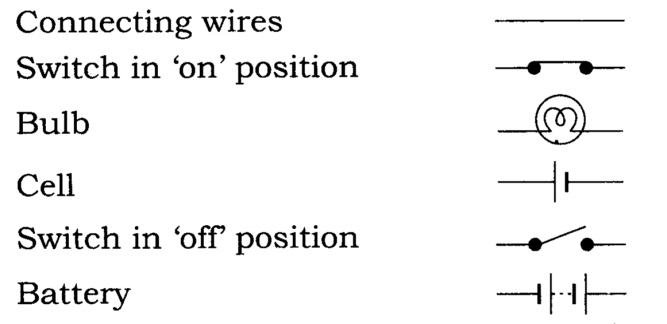
2. Draw the circuit diagram to represent the circuit shown in Fig.14.21.
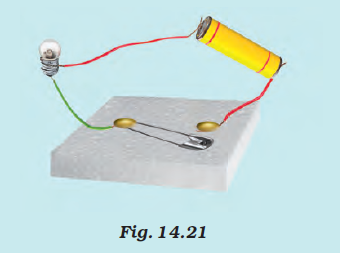
Answer –
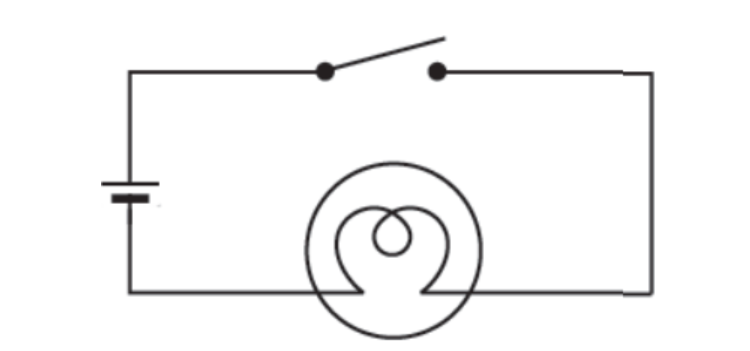
3. Fig.14.22 shows four cells fixed on a board. Draw lines to indicate how you will connect their terminals with wires to make a battery of four cells.
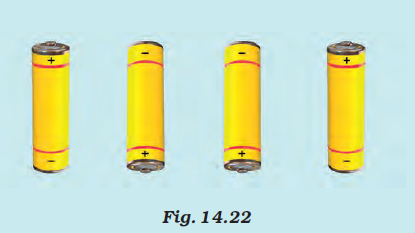
Answer –
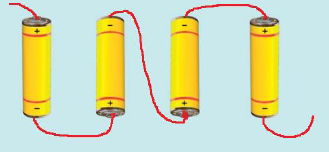
4. The bulb in the circuit shown in Fig.14.23 does not glow. Can you identify the problem? Make necessary changes in the circuit to make the bulb glow.
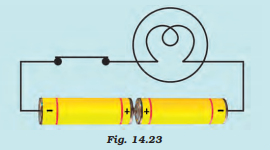
Answer – In the circuit above bulb is connected on either side.
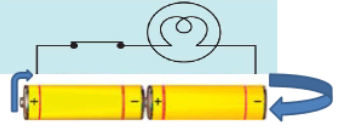
5. Name any two effects of electric current.
Answer – Electric current has the following effect :
(i) Electric current can give rise to heating and lighting.
(ii) Electric current can convert a straight conductor into a temporary magnet.
6. When the current is switched on through a wire, a compass needle kept nearby gets deflected from its north-south position. Explain.
Answer – When a current is switched on through a wire, the wire starts behaving as a magnet. Hence, when a compass needle is placed near the given current carrying wire, it gets influenced by the magnetic effect of electric current and gets deflected from its North- South position.
7. Will the compass needle show deflection when the switch in the circuit shown by Fig.14.24 is closed?
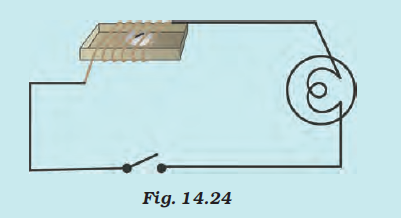
Answer – No. The given circuit does not have any current source. In the absence of current, the wire does not behave as a magnet and hence, the compass needle will not show any deflection.
8. Fill in the blanks:
(a) Longer line in the symbol for a cell represents its ________ terminal.
(b) The combination of two or more cells is called a ________.
(c) When current is switched ‘on’ in a room heater, it ________.
(d) The safety device based on the heating effect of electric current is called a ________.
Answer –
(a) Longer line in the symbol for a cell represents its positive terminal.
(b) The combination of two or more cells is called a battery.
(c) When current is switched ‘on’ in a room heater, it produces heat .
(d) The safety device based on the heating effect of electric current is called a fuse .
9. Mark ‘T’ if the statement is true and ‘F’ if it is false:
(a) To make a battery of two cells, the negative terminal of one cell is connected to the negative terminal of the other cell. (T/F)
(b) When the electric current through the fuse exceeds a certain limit, the fuse wire melts and breaks. (T/F)
(c) An electromagnet does not attract a piece of iron. (T/F)
(d) An electric bell has an electromagnet. (T/F)
Answer –
(a) To make a battery of two cells, the negative terminal of one cell is connected to the negative terminal of the other cell. (False)
(b) When the electric current through the fuse exceeds a certain limit, the fuse wire melts and breaks. (True)
(c) An electromagnet does not attract a piece of iron. (False)
(d) An electric bell has an electromagnet. (True)
10. Do you think an electromagnet can be used for separating plastic bags from a garbage heap? Explain.
Answer – No. Electromagnets can only attract magnetic materials. Plastic bag is a non-magnetic material and will not be attracted by an electromagnet. Hence, an electromagnet cannot be used for separating plastic bags from a garbage heap.
11. An electrician is carrying out some repairs in your house. He wants to replace a fuse by a piece of wire. Would you agree? Give reasons for your response.
Answer – No. The electrician cannot be allowed to replace the fuse in the house by a piece of wire. This is because every wire cannot be used as a fuse filament. A fuse filament must have a low melting point such that it could melt and break in response of large amount of current. Most of the wires have high melting points.
12. Zubeda made an electric circuit using a cell holder shown in Fig. 14.4, a switch and a bulb. When she put the switch in the ‘ON’ position, the bulb did not glow. Help Zubeda in identifying the possible defects in the circuit.
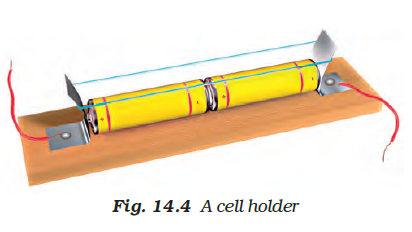
Answer – One of the reasons may be that the rubber band used in the cell holder may not be tight enough to keep the two cells in contact with each other. If the cells are not in proper contact with each other, then the circuit will not be complete and current will not flow through the circuit. Hence, the bulb will not glow. The other reason may be that the two cells are not connected properly. The negative terminal of one cell must be connected to the positive terminal of the other cell.
13. In the circuit shown in Fig. 14.25
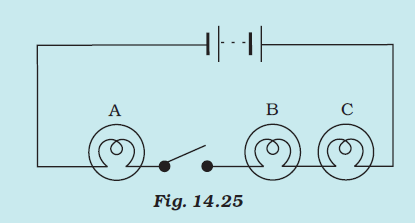
(i) Would any of the bulb glow when the switch is in the ‘OFF’ position?
(ii) What will be the order in which the bulbs A, B and C will glow when the switch is moved to the ‘ON’ position?
Answer –
(i) No, the bulb will not glow as the circuit is not complete when the switch is off
(ii) If the switch is On, all the bulbs glow simultaneously.

